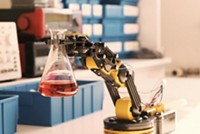Advertisement
Grab your lab coat. Let's get started
Welcome!
Welcome!
Create an account below to get 6 C&EN articles per month, receive newsletters and more - all free.
It seems this is your first time logging in online. Please enter the following information to continue.
As an ACS member you automatically get access to this site. All we need is few more details to create your reading experience.
Not you? Sign in with a different account.
Not you? Sign in with a different account.
ERROR 1
ERROR 1
ERROR 2
ERROR 2
ERROR 2
ERROR 2
ERROR 2
Password and Confirm password must match.
If you have an ACS member number, please enter it here so we can link this account to your membership. (optional)
ERROR 2
ACS values your privacy. By submitting your information, you are gaining access to C&EN and subscribing to our weekly newsletter. We use the information you provide to make your reading experience better, and we will never sell your data to third party members.
Education
Math For Chemists
Math methods courses let professors teach chemistry in greater depth
by Celia Henry Arnaud
May 2, 2011
| A version of this story appeared in
Volume 89, Issue 18

Mathematical methods courses have long been a fixture of physics departments, but they are rare in chemistry departments. Only a handful of chemistry departments offer them. The departments that do offer such classes find that they can put a chemical spin on mathematical tools that enable other chemistry classes to be taught with greater depth.
Most chemistry departments, however, send their students to the math department for any extra math training. But math departments “focus so much on the math itself” that they fail to fully explain how chemistry students can use that math in their work, says Jiwoong Park, a physical chemist at Cornell University who has taught a math methods class.
Curt Wittig, a professor of physical chemistry and chemical physics, has taught a math methods course at the University of Southern California for more than 20 years. Incoming students in physical and theoretical chemistry are required to take the class, “unless they can prove that their training is good enough that it would be redundant,” Wittig says.
Although it’s called math methods, Wittig emphasizes that it is not just a math course, nor is it remedial. “It combines the use of math with physics and chemical physics,” Wittig says. Indeed, lecture notes for the class, which are available on the Internet, are organized by physical chemistry topics rather than by mathematical methods. Students learn the tools they need in the context of chemical problems.
Wittig’s course helps “level the playing field” for incoming students in that brief window of time before they start doing research. But the class is “not low level, so it’s not a refresher course for calculus,” Wittig says. “If you come in thinking, ‘I’ll brush up on my linear algebra or calculus,’ you’re in for a big surprise.”
Andrei Sanov, a physical chemistry professor at the University of Arizona, took Wittig’s class when he was a graduate student at USC in the 1990s. He has long wanted to teach such a class at Arizona, and last semester he finally got his chance.
“We noticed that when we teach quantum mechanics and spectroscopy at the graduate level we spend a lot of time reviewing topics in mathematics,” Sanov says. He and his colleagues decided that they needed to offer a course that would cover the mathematics chemists need so that other classes could focus on chemistry.
Sanov’s class differs from Wittig’s, with a syllabus that fast-forwards through undergraduate mathematics, covering topics in calculus, differential equations, linear algebra, and statistics. His original “wish list” syllabus looked like one for a two- or three-semester course, he says. “I had to cut it down quite a bit,” he says. Even then, he could teach only some of the topics.
“The area of mathematics is enormous and overwhelming. It’s impossible in a one-semester course to review everything,” Sanov says. He teaches mathematics using examples from quantum mechanics, kinetics, and spectroscopy. Most students were physical chemists, but the class also included several analytical chemists and even one organic chemist.
Arizona’s math methods course was scheduled as a double period with quantum mechanics. The scheduling gave Sanov the flexibility to double up on the math methods early in the semester and then ramp up the science as the semester proceeded. “The idea was to give the students the techniques and skill of mathematics at the beginning of the semester so we could take the quantum course to a higher level,” he says.
At one university, the math methods course is hiding in plain sight. For more than 50 years, Purdue University’s chemistry department has offered a math methods class, but a casual observer could be forgiven for not realizing that because the class goes by the name of Advanced Analytical Chemistry.
The class assumed its current form during the 35 years Fred E. Lytle taught it. Since Lytle’s retirement in 2008, Garth J. Simpson has been the instructor.
“The subject matter is basically the other half of analytical chemistry,” Simpson says. “It’s what you do with the results after you’ve obtained them.”
Simpson’s goal is to give students mathematical tools for mining the rich veins of data generated by modern instrumentation. These tools include Fourier methods, autocorrelation, digital filtering, and statistics. “It’s everything you need to understand a measurement and noise,” he says. Simpson expects students to already know the basics of calculus and linear algebra.
The heart of the course is three weeklong take-home exams designed to give students the time needed to work through and “wrap their heads around a complicated set of problems,” Simpson says.
Simpson considers the exams to be the best approach for promoting the critical thinking and problem-solving skills students will need after they graduate. Students really learn the material, he says, when they have to apply the methods while wrestling with problems for a week.
The exams are “open world, and the questions are drawn from compelling scientific problems,” Simpson says. He selects problems from current research efforts under way at Purdue and in the broader community. Some of the solutions students come up with have even gone on to become the subjects of articles in the journal Analytical Chemistry.
The course has evolved over time, Simpson says, with topics like principal component analysis, linear discriminant analysis, and dimension reduction approaches becoming more important, but “the framework is just solid measurement science.” The topics are chosen with the aim of teaching students how to optimize the signal-to-noise ratio of analytical instruments. “Those sorts of fundamental laws don’t change much over time,” he adds.
At least one chemistry department that used to offer a math methods class has been unable to continue teaching it.
For more than 10 years, the University of Wisconsin, Madison, offered an intensive six-week math methods class to get incoming physical chemistry students up to speed on the math needed for quantum mechanics and statistical mechanics, says F. Fleming Crim, a physical chemist at the university.
“Someone was always teaching it as an extra course on a volunteer basis, and we finally stopped doing it about five years ago because none of us really had the time along with other responsibilities,” Crim says. The physical chemistry professors now “teach the math as they go along.” Although they recognize the benefits of such a course, they aren’t willing to sacrifice other classes for it and have no plans to restart the math methods class, Crim says.
Elsewhere, math methods classes for chemists are hard to find. Neither Sanov nor Wittig has encountered similar classes at other universities, but they hear about plenty of interest. “I’ve had many people at other universities tell me they wish they had such a course,” Wittig says.
If other chemistry departments want to offer such a class, Wittig advises them to “do the homework” first because “there are many ways to fail.”
“Figure out exactly what you want to achieve and figure out who’s going to teach it,” he says, because they’ll need to teach it for several years to get it off the ground. “This has to be something that you really want to have and to maintain,” Wittig says. “It’s not an experiment that you can get rid of and recover every so often.”





Join the conversation
Contact the reporter
Submit a Letter to the Editor for publication
Engage with us on Twitter